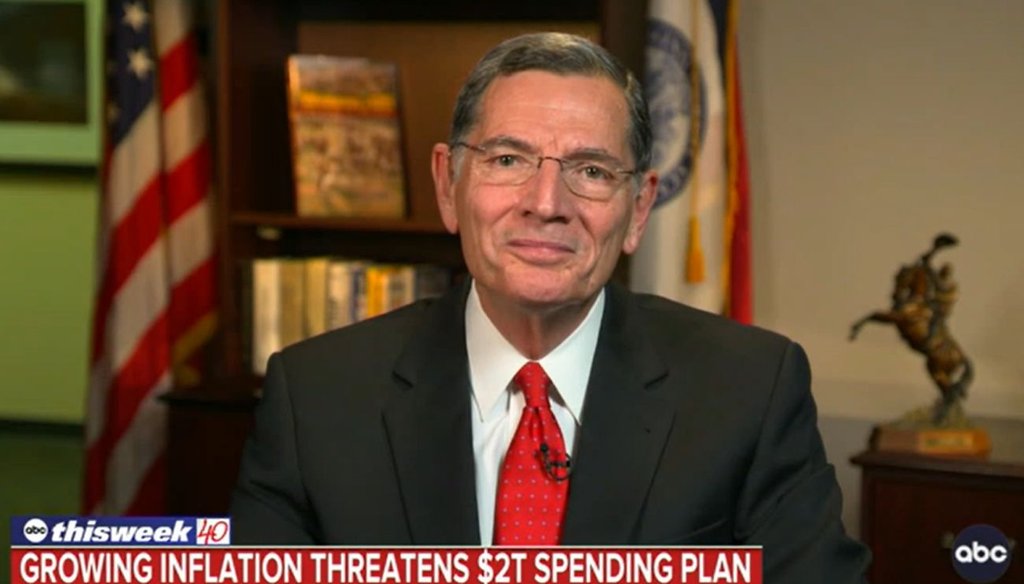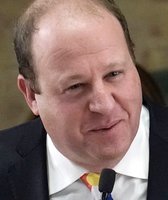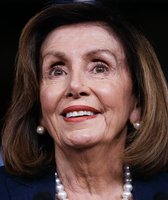Get PolitiFact in your inbox.

Sen. John Barrasso, R-Wyo., appeared on the Nov. 14, 2021, edition of ABC's "This Week." (Screenshot)
If Your Time is short
• The Urban Institute-Brookings Institution Tax Policy Center, an independent arbiter of tax policies, projects that between 20% and 30% of lower- and moderate-income households will have lower after-tax incomes under Biden’s proposal in 2022.
• However, the reductions would be small in terms of raw dollars and as a percentage of income. And they would be the result of the murky, indirect impact of a corporate tax increase, not any direct tax that would show up on an individual tax return or paystub.
• As for two-thirds of millionaires getting a tax break, that’s accurate due to proposed changes to the state and local tax deduction, though the benefits would be significantly reduced starting in 2023.
As the Democrats’ Build Back Better bill moves closer to a vote in the House, Republicans have stepped up their criticism of the safety net legislation.
In a Nov. 14 interview on ABC’s "This Week," Sen. John Barrasso, R-Wyo., took aim at the proposal’s tax provisions.
He said, "The experts are telling us that 30% of middle-class Americans will end up paying higher taxes, and what Nancy Pelosi has shoved in — the special tax breaks for millionaires in California, New York, New Jersey — that is actually going to give a tax break to two-thirds of the millionaires in America."
Some of what Barrasso said tracks with what independent groups have found, but it glosses over some important context in those analyses.
Because the tax proposal is not finalized, we will continue our practice of analyzing such claims without offering a Truth-O-Meter rating. The House may not vote on this version of the tax provisions, and even if it does, the Senate may not sign off on what the House passes.
Barrasso’s office did not respond to an inquiry for this article, but his talking points coincide with elements of a recently released analysis of the tax provisions by the Urban Institute-Brookings Institution Tax Policy Center, an independent arbiter of tax impacts whose reports are widely scrutinized in D.C. policy circles.
Broadly speaking, though, the Tax Policy Center’s conclusion clashes with Barrasso’s, by framing the tax changes as overwhelmingly hitting wealthy taxpayers, not "middle-class Americans."
"The major tax changes in the latest version of President Biden’s Build Back Better plan would cut taxes on average for nearly all income groups in 2022," the group wrote in a blog post explaining its analysis. "The exception: Those in the top 1%, who will make about $885,000 or more. They’d pay about $55,000 more than under current law. Those in the top 0.1%, who make about $4 million and up, would pay an additional $585,000 on average, a 5.9% reduction in their after-tax income."
One of Biden’s signature promises during his presidential campaign was that he wouldn’t raise taxes on American households earning less than $400,000. The Tax Policy Center analysis provides some support for the notion that the bill is standing by this promise, but it also appends an asterisk.
It boils down to what you consider to be a tax, or a tax increase.
Americans pay all sorts of taxes, some levied by states or localities, and some by the federal government. On the federal level, Americans are taxed directly on their incomes, as well as in deductions from their paychecks for Social Security and Medicare.
Corporations are taxed on their profits as well, with different rates. One part of the bill’s tax provisions is to raise the top corporate tax rate to 26.5% from its current level of 21%.
The mathematical models that the Tax Policy Center and other groups use to project how tax law changes affect various categories of taxpayers focus on direct taxes. But they also factor in an indirect impact on individuals from corporate tax increases. The idea is that corporations will pass along the cost of these tax increases to regular people, mainly through lower returns for investors and lower wages for workers. These potential declines in after-tax income, the analysts say, will have a pocketbook effect equivalent to a tax increase.
The Tax Policy Center model measures the overall impact of tax changes on taxpayers in each of five income tiers, or quintiles. In addition, the model seeks to capture the impact on especially high-earning households by studying what would happen to subgroups within the highest tier, such as the 80th to 90th percentiles in income, the top 1%, and the top 0.1%.
The Tax Policy Center sought to separate out the "winners" from the "losers" of Biden’s tax proposals. It did this by examining each of these income groups and predicting what percentage of them could expect to see a decline or an increase in their after-tax earnings — either through higher direct taxes or reduced income. The analysis also provided the average amount of income gained or lost for members of each of these groups.
The analysis for 2022 found that among people in the lowest of the five income tiers, only about 5.5% would see lower after-tax income under the Biden proposal. Meanwhile, 15% of the second-lowest tier would see a drop in after-tax income, and 22.8% of those in the middle tier would. For the second-highest tier, 30.3% of earners would see a decline in after-tax income. And for the income brackets between the 80th and 95th percentiles — which phase out at $369,300 — between 29% and 30% would see their after-tax incomes drop.
This part of the analysis supports Barrasso’s statement: Depending on the income level, between 15% and 30% of taxpayers could see lower after-tax income, under Biden’s plan, according to the Tax Policy Center.
But this is also where the asterisk comes in.
The only reason for the projected declines in after-tax income for lower- and middle-income taxpayers is the potential impact of the corporate tax rate increase, which will never show up as a line item on a tax return or a paystub. Rather, it’s a murky impact to measure, and economists disagree about how much lower- and middle-income households will actually be affected.
In its model, the Tax Policy Center estimated that 80% of the corporate tax increase would be borne by corporate shareholders through reduced investment returns and dividends. The remaining 20% would be borne by workers through reduced wages. This breakdown is similar to those used by the Treasury Department and Congress’ Joint Committee on Taxation. Some households could be hit by both impacts. For instance, members of a household might see lower returns on the stock investments in their 401(k) as well as experiencing lower wages.
Regardless, the Tax Policy Center projects that the hit to incomes for these taxpayers will be small, ranging between $30 and $70 for the bottom 60% of earners and between $110 and $230 for those approaching the 95% tier. For the top earners, this increase amounts to 0.06% of their income. For lower income groups, the increase would be about 0.1% of income.
By comparison, the taxpayers in these categories who end up better off due to Biden’s changes would see more substantial gains — between $1,700 and $2,200, depending on a household’s income level.
In fact, if you set aside the hard-to-predict corporate income tax effects and look just at the more easily verifiable direct taxes, the Tax Policy Center projects that essentially all households earning $500,000 or less would see a tax cut for 2022.
"If you look only at the direct taxes people pay, this bill pretty much achieves Biden’s goal," said Howard Gleckman, a senior fellow with the Tax Policy Center. "Less than one-tenth of 1% of people making less than half a million dollars would actually pay more in direct taxes."
Barrasso is on safer ground for the second part of his statement, though it’s worth pointing out additional context.
The senator is referring to a provision known as the state and local tax deduction, or SALT. This provision allowed taxpayers to deduct the cost of their local taxes from the income used to calculate their federal tax liability. The deduction is generally considered to benefit taxpayers in higher-tax states, many of which vote Democratic on the presidential level. However, many economists see it as a regressive tax policy since the value of the deduction is highest for wealthier taxpayers.
The 2017 tax law that was passed exclusively by Republicans and signed by former President Donald Trump capped the SALT deduction.
The current version of the Build Back Better bill would raise the cap substantially for tax years 2021 through 2030, and the Tax Policy Center analysis projects that it would be a boon for millionaires.
Gleckman said the analysis found that for households making more than $1 million a year, about two-thirds would get a tax cut, and that tax cut would average $17,000 a year.
By contrast, the center concluded, the changes "would provide almost no benefit for middle-income households. It would reduce their 2021 taxes by an average of only $20. Even those making between $175,00 and $250,000 would get a tax cut of just over $400, or about 0.2% of after-tax income."
The main caveat here is that the boon for millionaires would last only that first year, 2022.
In 2023, Gleckman said, a corporate tax change that would affect many of the highest income households kicks in. The center didn’t calculate the specific number of households affected or what the tax hit would be, but Gleckman said the tax burden on high-income households would almost certainly increase in 2023.
Our Sources
John Barrasso, interview on ABC’s "This Week," Nov. 14, 2021
Congress.gov, House Budget Committee report for H.R. 5376, accessed Nov. 15, 2021
Urban Institute-Brookings Institution Tax Policy Center, "Build Back Better 2.0 Still Raises Taxes For High Income Households And Reduces Them For Others," Nov. 11, 2021
Urban Institute-Brookings Institution Tax Policy Center, "T21-0261 - Tax Units with a Tax Increase or Tax Cut in Build Back Better Act as Reported by House Budget Committee, by Expanded Cash Income Percentile, 2022," accessed Nov. 15, 2021
Urban Institute-Brookings Institution Tax Policy Center, "T21-0273 - Tax Units with a Tax Increase or Tax Cut from Individual Income and Payroll Tax Provisions in Build Back Better Act as Reported by House Budget Committee, by Expanded Cash Income Percentile, 2022," accessed Nov. 15, 2021
Urban Institute-Brookings Institution Tax Policy Center, "The Latest SALT Cap Fix Would Mostly Benefit High Income Households, Do Little For Middle-Income People," Nov. 3, 2021
PolitiFact, "Would Joe Biden’s proposals raise taxes on 60% of Americans? Not directly," June 30, 2021
PolitiFact, "Proposed tax increases in Build Back Better aimed at the wealthy, not workers and families," Nov. 8, 2021
PolitiFact, "What a GOP ad omits about Democrats’ spending proposal," Oct. 21, 2021
PolitiFact, "Biden Promise Tracker: No direct tax increases proposed for households under $400,000," April 20, 2021
Interview with Howard Gleckman, senior fellow with the Urban Institute-Brookings Institution Tax Policy Center, Nov. 15, 2021
































